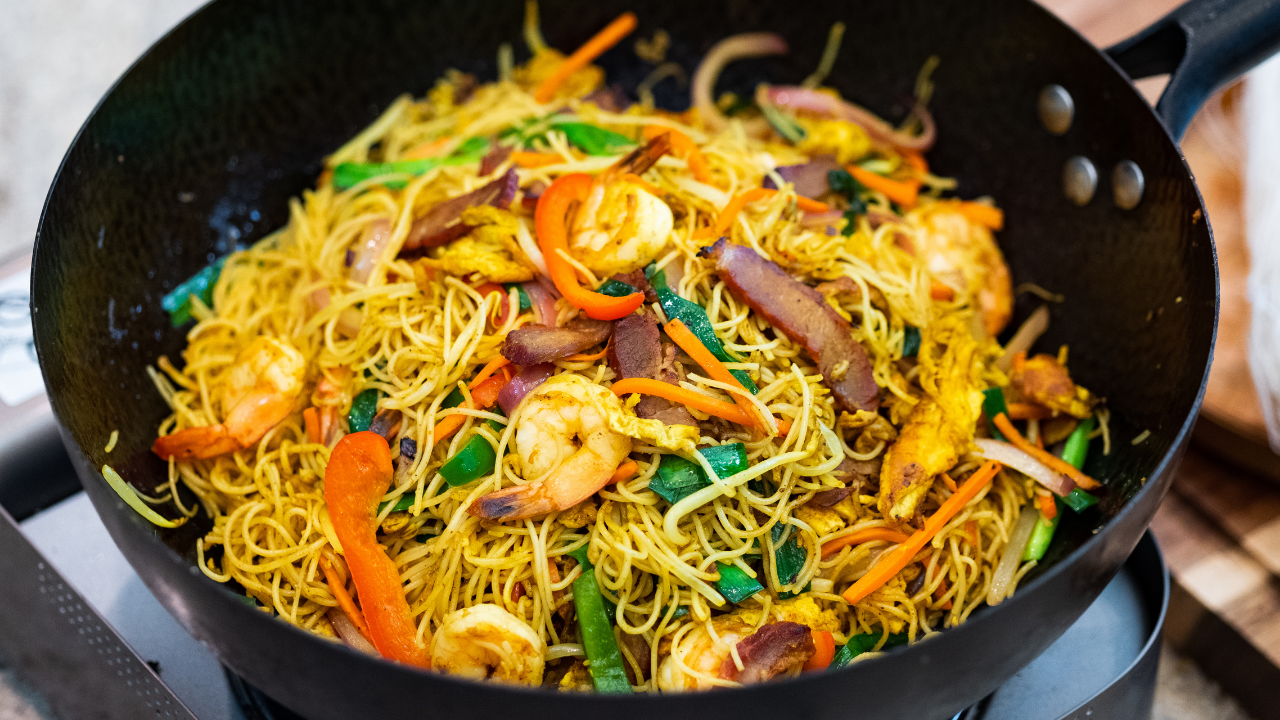Despite being named after Singapore, this recipe was actually born in HK in the 1960s, the time when HK was a British colony. As HK became the transportation hub between Europe and Southeast Asia, lots of cuisines from all over the world started creating sparks in this little island. With influence from the Indian spices, this stir-fried curry rice noodle dish found its way and spread globally. However, I still have no idea why it is named after Singapore. If you know, please leave a comment below so we can all learn about it.
INGREDIENTS (2 servings)
For the noodles and protein
- 200 grams of dried rice stick noodle
- 6 cups of boiling water to soak the noodles
- 70 grams of char siu, julienned
- 150 grams (5.3 oz) of shrimp
- a pinch of salt
- black pepper to taste
- 2 eggs
Vegetables and aromatics
- 70 grams (2.5 oz) of multi color bell pepper
- 42 grams (1.5 oz) of carrot
- 42 grams (1.5 oz) of onion, sliced thinly
- 42 grams (1.5 oz) of bean sprout
- 28 grams (1 oz) of garlic chive
- 2 cloves of garlic, sliced thinly
For the seasonings
- 1 tbsp of soy sauce
- 1 tbsp of fish sauce
- 2 tsp of oyster sauce
- 1 tsp of sugar
- 1-2 tsp of curry powder depending on your taste
- 1 tsp of turmeric powder
Rice noodle is what you need for this recipe. It is also labeled as rice vermicelli noodles or mi fun (米粉). You will find 3 different levels of thickness on the market mainly. They usually don’t label the thickness but the package is translucent so you can see through it.

- This right one is very thin and labeled as angle hair. It works for this recipe and the taste will come out the same but you will have to cook it for a shorter time. It does break easily. It likes to tangle with each other so when you fluff it in the wok, it flies everywhere. However, I found this one widely available in big supermarkets in the USA, such as public, Walmart, and target. That’s why I want to bring up this option to you even though it is not the best.
- The middle one is my favorite because it not too thin or too thick. It doesn’t take too long to cook. It doesn’t break easily and doesn’t tangle too much. It works like a magic in the wok.
- This left one is extra thick, I normally use it to make noodle soup, so I didn’t test it in this recipe. But you can definitely give it a go if that is your only option. You just have to adjust the cooking time and heat base on your own judgment. If you did try, leave a comment below and let me know how it goes.
By the way, it really doesn’t matter what brand you use, because I have tried many and I never had any issues.
INSTRUCTIONS
I will be using 200 grams of dried rice noodles, which are 2 servings. To prepare the noodles, you just bring 8 cups of water to a boil and turn off the heat. Drop the noodles right in there. Let it soak for about 5 minutes. If you are using the angle hair, you will soak for only 2 minutes. We don’t want to over cook them, otherwise they will turn mushy when you stir fry them. You can give it a bite to test it. The noodles should be a little bit chewy at the center.
Take them out and spread them on a cooling rack. Let the heat help to evaporate the excess moisture. This is the key to avoid clumpy and sticky noodles. I know a lot of recipes will tell you to rinse the noodles with cold water. I don’t recommend this because it will bring in too much moisture, which is the number one enemy for this dish; it makes the noodles stick to the wok badly.

While waiting, we can go through the rest of the ingredients. Although you can use any kind of meat in your stir fry, roasted pork is what makes this dish Cantonese. To be specific, not just regular roasted pork, it is Char siu, which is also known as Chinese BBQ pork and it is so popular in HK that it became the characteristic ingredient for a lot of HK style dishes, such as egg foo young, char siu fried rice, char siu noodle soup, and char siu steam bun… If you are not living in HK, and you want to make it authentic, you’ll just have to either buy it from china town or bake it yourself. I do have a recipe; you can click here to watch the video. If you don’t have char siu and you don’t want to spend time making it, the closest replacement will be some sweet-savory BBQ meat.

Here is 150 grams of peeled and deveined shrimp. Simply season it with a pinch of salt and some black pepper to taste. If you don’t eat shrimp, that is all right. Singapore noodles can also be made with Firm tofu, marinated chicken or pork slices.

Crack 2 eggs and beat them well until you don’t see any obvious egg white. Set it aside.

Next, we will talk about vegetables. There are no restrictions because you can throw almost anything into your stir fry, but Cantonese restaurants usually will use julienned carrots, thinly sliced onion, bell pepper strips, bean sprouts, garlic and garlic chives (韭菜 Jiucai)

Before we start cooking, let’s put all the seasonings together.
- 1 tbsp of soy sauce
- 1 tbsp of fish sauce
- 2 tsp of oyster sauce
- 1 tsp of sugar
- 1-2 tsp of curry powder depending on your taste.
- 1 tsp of turmeric powder

Although you can use any type of curry powder that you have, the brand does affect the final taste. You can experiment with a few and pick your favorite one. Some people also use curry paste, which works but you will have to adjust the seasoning because every brand of curry paste has a different level of sodium, sugar and spiciness. For example, I have used this lee kum kee curry paste, it is so mild and sweet compare to the curry powder that I am using today so I will have to omit the sugar and add some chili powder to boost up the spiciness. This is the key ingredient that gives Singapore noodle it’s signature flavor.
Turmeric is optional because curry powder already contains turmeric. But the brand that I am using is not giving the dish that bright yellow color so I will have to add a little extra turmeric to make the noodles appealing. You may not need it depending on what you use.
Turn the heat to high and heat your wok until smoking hot. Add a few tbsp of oil and swirl it around to create a nonstick layer. Pour in the egg and wait for it to set. Then break the egg into big pieces. Push the egg to the side so you have room to sear the shrimp. The wok is super hot, it only takes 20 seconds for the shrimp to turn pink. Now push the shrimp to the side and toss in the char siu because I am using leftover char siu. I want to stir it for 10-15 seconds over high heat to reactivate the flavor. Of course, if you are using freshly baked char siu or bbq meat, you can add it to the wok at the end to complete the dish. Take all the proteins out and set them aside.

The wok looks a bit dry, I will add 1 more tbsp of oil. Throw in the garlic, and carrot because carrot takes longer to cook. Give them a quick stir then add the noodles. Switch the spatula to tongs as they work great at fluffing noodles. Make sure the heat is on high the whole time. Not only does it ensure the wok hay affect, but also it prevents the noodles from sticking to the wok. A lot of people don’t know about this, so their food always sticks to the cookware. When this happens, people tend to add more oil to save the dish, but then your noodles will come out extra oily.

After a few minutes of stirring, add the sauce, along with the vegetables except the garlic chives. Introduce the protein back into the wok. I prefer my veggies to be fresh and crunchy. So, I add them now which is quite late. If you want to cook them more, you can add them to the wok earlier, not a problem at all. Quickly stir to make sure the flavor is well combined. A large wok is necessary, so your noodles don’t fly everywhere onto your countertop. Turmeric is a useful reference parameter, you just go with the color. Once you don’t see any white rice noodles, add the garlic chives and give it a final toss. You are done.

Before serving, always give it a taste to adjust the flavor. As I mentioned before, different brands of curry powder, curry paste, even soy sauce may vary in sodium level.
This tastes so good. The noodles are thoroughly tossed in the wok, very fluffy and slightly toasty. The curry powder is pleasantly invasive because it works so well on these spindly rice noodles. Every string is packed with complex flavors. This is a very interesting dish and it shows how multicultural Cantonese cooking could be. I hope you give this a try soon.





































































